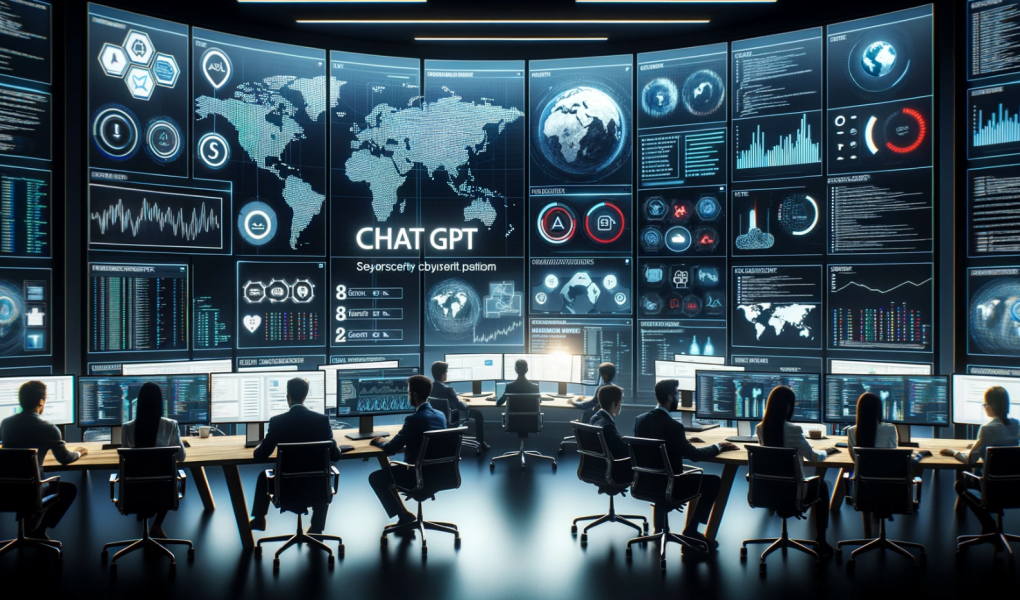If you’re anything like me, you’re always on the lookout for the latest tools and technologies that can help us combat the ever-growing threats in the digital world.
Today, I’m thrilled to introduce you to a game-changing tool in our cybersecurity arsenal: ChatGPT.
Let’s dive deep into the role of ChatGPT in cybersecurity, specifically focusing on threat analysis and response.
What is ChatGPT?
Before we go into the nitty-gritty, let’s get some basics out of the way. ChatGPT is a state-of-the-art language model developed by OpenAI. It’s designed to understand and generate human-like text based on the prompts it receives.
Think of it as an AI-powered chatbot, but on steroids.
ChatGPT’s Role in Cybersecurity
Now, you might be thinking, “That’s cool and all, but how does a chatbot fit into cybersecurity?” Well, the answer is multifaceted.
Here are some ways ChatGPT is revolutionizing the cybersecurity landscape:
1. Real-time Threat Analysis
What Does “Real-time” Mean?
In the context of cybersecurity, “real-time” refers to the immediate processing and analysis of data as it is created or received. When we talk about real-time threat analysis, we mean the capability to identify and assess threats the moment they emerge, without any significant delay.
ChatGPT’s Real-time Capabilities
Given its advanced machine learning algorithms, ChatGPT can process vast amounts of data at lightning speed. This makes it particularly useful for real-time operations.
1. Pattern Recognition
One of the core strengths of ChatGPT in real-time threat analysis is its ability to recognize patterns. By being trained on extensive datasets comprising various cyber threats, ChatGPT can quickly identify patterns that might be indicative of a breach or an attack. For instance, it can spot unusual login attempts, data transfer patterns, or irregular network traffic that might go unnoticed by traditional systems.
2. Anomaly Detection
Beyond recognizing known threat patterns, ChatGPT is adept at detecting anomalies. Anomalies are deviations from the norm that might indicate a potential threat. For example, if there’s a sudden spike in data being transferred out of a system, ChatGPT can flag it as suspicious, even if that particular pattern hasn’t been explicitly labeled as a threat before.
3. Contextual Analysis
ChatGPT doesn’t just look at data in isolation. It can contextualize information, meaning it understands the broader implications of a particular data point. For instance, while a single failed login attempt might not raise alarms, multiple failed attempts from various locations worldwide in a short span might be deemed suspicious.
4. Integration with Other Systems
ChatGPT can be seamlessly integrated with other cybersecurity tools and systems. This means it can pull data from various sources, be it network traffic monitors, firewall logs, or intrusion detection systems, to provide a comprehensive real-time threat analysis.
Advantages of Real-time Threat Analysis with ChatGPT
- Proactive Defense: Instead of reacting to threats after they’ve caused damage, real-time analysis allows cybersecurity professionals to take proactive measures. Immediate threat identification can lead to faster containment and mitigation.
- Resource Optimization: With ChatGPT handling the bulk of the real-time analysis, human analysts can focus on more complex tasks, ensuring that resources are used efficiently.
- Enhanced Visibility: ChatGPT provides a clear, real-time view of the organization’s digital environment, making it easier to spot vulnerabilities and take corrective action.
Real-time threat analysis with ChatGPT is akin to having a vigilant guard continuously monitoring your digital premises. Its ability to process and analyze data instantly, recognize patterns, detect anomalies, and provide contextual insights makes it a valuable tool in the cybersecurity toolkit.
While ChatGPT is incredibly powerful, it’s essential to complement it with other tools and human expertise for a holistic cybersecurity strategy. After all, in the ever-evolving world of cyber threats, a multi-faceted defence is the best offence.
2. Automated Incident Response
Understanding Incident Response
Incident Response (IR) is the approach an organization takes to handle and manage the aftermath of a security breach or cyberattack. Its primary goal is to handle the situation in a way that limits damage and reduces recovery time and costs. A proper IR can also aid in preventing future incidents.
The Need for Automation
In the fast-paced digital realm, threats can emerge and escalate rapidly. Manual responses, even when executed by the most experienced teams, can sometimes be too slow to effectively counteract these threats. Automation helps in speeding up response times, ensuring consistent reactions to specific threats, and reducing human error.
How ChatGPT Enhances Automated Incident Response
1. Immediate Threat Validation
Upon detecting a potential threat, ChatGPT can instantly validate its authenticity. For instance, it can differentiate between a false alarm and a genuine threat, ensuring that resources are focused on actual problems.
2. Automated Communication
ChatGPT can be programmed to notify the relevant parties about the incident instantly. Whether it’s sending alerts to the cybersecurity team, informing stakeholders, or even guiding affected users on immediate steps, ChatGPT ensures timely communication.
3. Prescriptive Actions
Based on the nature of the threat, ChatGPT can suggest or even autonomously execute predefined actions. For example, if it detects a certain malware signature, it might automatically isolate the affected system or initiate a specific malware removal process.
4. Integration with Security Tools
ChatGPT can integrate with various security tools, orchestrating a coordinated response. It can pull data from intrusion detection systems, firewalls, and endpoint security solutions, collating information and triggering appropriate countermeasures across tools.
5. Dynamic Response Playbooks
While many automated responses are based on static rules, ChatGPT’s machine learning capabilities allow it to adapt and evolve its response strategies. As it encounters more incidents and learns from them, it can refine its playbooks to ensure more effective responses in the future.
6. Post-Incident Analysis
After an incident has been managed, ChatGPT can assist in analyzing what happened. It can provide a detailed timeline of events, suggest areas of vulnerability, and even recommend measures to prevent similar incidents.
Advantages of Automated Incident Response with ChatGPT
- Speed: Automated responses are almost instantaneous, reducing the window of exposure and potential damage.
- Consistency: Automation ensures that the same type of threat is always handled in the same effective manner, regardless of when or where it occurs.
- Resource Efficiency: By handling routine threats autonomously, ChatGPT allows cybersecurity professionals to focus on more complex or novel threats.
- Continuous Learning: ChatGPT’s adaptive capabilities ensure that the system gets better over time, learning from each incident and refining its response strategies.
Automated Incident Response with ChatGPT transforms the way organizations handle cyber threats. By providing immediate, consistent, and adaptive responses, ChatGPT not only mitigates the impact of incidents but also paves the way for a more resilient cybersecurity posture.
However, as with all automation, it’s essential to maintain human oversight and regularly review and update response strategies to ensure their continued effectiveness.
3. User Education and Training
Phishing attacks, ransomware, and social engineering tactics prey on human vulnerabilities. ChatGPT can be used to create real-time simulations or training modules to educate employees about these threats. By interacting with an AI that simulates these attacks, users can learn to recognize and respond to them in a safe environment.
The Importance of User Education
At the heart of many cybersecurity incidents are human errors or oversights. From clicking on a malicious link to using weak passwords, human vulnerabilities often present easy entry points for cybercriminals. Thus, educating users becomes a critical line of defence against these threats.
How ChatGPT Elevates User Training
1. Interactive Simulations
ChatGPT can create dynamic, real-time simulations that mimic cyber threats. Users can interact with these simulations to understand the nuances of various attacks like phishing, ransomware, or social engineering tactics. By engaging with these simulations, users can recognize the signs and learn the appropriate response measures in a controlled environment.
2. Personalized Learning
Not everyone has the same level of cybersecurity awareness. ChatGPT can tailor its training modules based on the user’s knowledge level. It can start with basic concepts for beginners and delve into advanced topics for more tech-savvy individuals. This ensures that each user gets the most out of their training experience.
3. Instant Feedback
One of the strengths of using ChatGPT for training is the immediate feedback it provides. If a user makes an error during a simulation, ChatGPT can point it out right away, explain the implications, and guide the user on the correct course of action.
4. Regular Knowledge Checks
ChatGPT can periodically quiz users on cybersecurity best practices to ensure that the knowledge sticks. These quizzes can be adaptive, with the difficulty adjusting based on the user’s performance. This not only reinforces learning but also keeps cybersecurity awareness top of mind.
5. Up-to-date Information
The cybersecurity landscape is constantly evolving, with new threats emerging regularly. ChatGPT can be updated with the latest information, ensuring that users are always trained on current threats and best practices.
6. Scalability
Whether it’s for a small team or an enterprise with thousands of employees, ChatGPT can scale its training modules to accommodate any number of users. This makes it a versatile solution for organizations of all sizes.
Advantages of User Education with ChatGPT
- Engagement: Interactive simulations and personalized learning modules ensure users are actively engaged, leading to better retention of information.
- Practical Experience: Simulated scenarios allow users to gain practical experience in handling threats, making them better prepared for real-world situations.
- Cost-effective: Using ChatGPT for training can reduce the costs associated with traditional training methods, such as workshops or external consultants.
- Continuous Learning: The adaptive nature of ChatGPT ensures that users are always learning and evolving their cybersecurity knowledge.
User education and training play a pivotal role in strengthening an organization’s cybersecurity posture. ChatGPT brings a fresh, interactive, and adaptive approach to this training, ensuring that users are not just informed but also equipped to handle cyber threats effectively. By making training engaging and relevant, ChatGPT empowers users to become an active part of an organization’s cybersecurity defence.
4. Threat Intelligence Sharing
ChatGPT can act as a bridge between different cybersecurity platforms, facilitating seamless threat intelligence sharing. It can translate technical jargon into layman’s terms, making it easier for teams to collaborate and stay updated on the latest threat landscapes.
ChatGPT: Not a Silver Bullet
While ChatGPT offers numerous benefits in the realm of cybersecurity, it’s essential to remember that it’s not a silver bullet solution. Like any other tool, its effectiveness depends on how it’s used. Here are some things to keep in mind:
- Data Quality Matters: ChatGPT’s analysis is only as good as the data it’s trained on. Ensure that you’re feeding it high-quality, relevant data for optimal results.
- Human Oversight is Crucial: While ChatGPT can automate many processes, human oversight remains paramount. Always double-check the AI’s findings and use it as a tool to augment, not replace, human expertise.
- Stay Updated: The world of cybersecurity is ever-evolving. Make sure you’re continually updating and training ChatGPT on the latest threat landscapes to stay ahead of the curve.
Wrapping Up
ChatGPT’s role in cybersecurity, particularly in threat analysis and response, is undeniable. It offers a fresh perspective, speed, and efficiency that can greatly aid cybersecurity professionals in their daily battles against digital threats.
However, as with all tools, it’s essential to use ChatGPT wisely. By combining the AI’s capabilities with human expertise and continual updates, we can create a formidable defence against the ever-growing threats in the digital realm.
I hope you found this deep dive into ChatGPT’s role in cybersecurity insightful. Remember, the digital world is a double-edged sword. While it offers countless benefits, it also comes with its fair share of threats.
Stay safe, stay informed, and always be one step ahead of the bad guys!




